Driving a heavy commercial vehicle is never an easy task, and in a country like Nepal, it comes with even greater challenges. For logistics operators, construction companies, and long-distance transporters, ensuring road safety is crucial for safeguarding lives and maintaining business efficiency. Here is a detailed look at the most important safety practices while driving heavy commercial vehicles in Nepal:
Conduct a safety check
Before embarking on any journey, drivers must conduct a thorough check of their vehicle. Heavy trucks are complex machines, and even a minor issue can become dangerous on the road. Ensure the air brakes are working correctly and there are no leaks. Check for proper inflation and signs of wear and tear. Uneven tyres can be hazardous on steep mountain roads. A 15-minute inspection can prevent hours of trouble and potentially save lives.
Follow speed limits
Nepal’s highways and city roads have varying speed restrictions, and drivers of heavy commercial vehicles must adhere to them strictly. Due to their weight, heavy vehicles require longer stopping distances, and speeding can render braking ineffective. Stick to posted limits or drive even slower on unfamiliar or steep roads. Make sure to reduce speed while approaching curves, narrow bridges, or crowded areas.
Practice defensive driving
Defensive driving is essential for heavy commercial vehicle operators. Unlike small cars, trucks cannot swerve or stop suddenly. Drivers need to anticipate risks and be prepared for sudden actions by other motorists or pedestrians. Maintain a safe following distance and be alert to motorbikes and smaller vehicles that cut in too closely. Be sure to use mirrors frequently to check for blind spots.
Adapt to Nepal’s terrain
Nepal’s geography is one of the biggest challenges for HCV drivers. Roads through hilly and mountainous regions demand extra caution. Use lower gears while driving uphill to maintain steady power and prevent rollback. On downhill drives, never rely only on brakes. Use engine braking to control speed. Continuous braking can cause overheating and brake failure.
Avoid overloading
Overloading is a common problem in the transportation sector, but it is particularly hazardous for heavy commercial vehicles. Extra weight increases stopping distance and reduces vehicle stability. Overloaded trucks put more strain on brakes, tyres, and suspension systems. On steep or narrow roads, overloaded vehicles are more likely to tip over. Always respect the manufacturer’s weight limits and local transport regulations.
Prioritise cargo safety
Cargo that is not properly loaded or secured can shift during transit, causing imbalance or damage. Use straps, locks, and nets to secure goods. Distribute weight evenly to avoid tipping and check cargo security during rest stops. For trucks carrying hazardous materials, follow specific safety regulations to prevent accidents and ensure the safety of all personnel.
Conclusion
Heavy commercial vehicles are the lifeline of Nepal’s economy but driving them comes with great responsibility. With the right precautionary measures, businesses can ensure that their heavy commercial vehicles not only transport goods effectively but also keep roads safer for everyone.





Comments